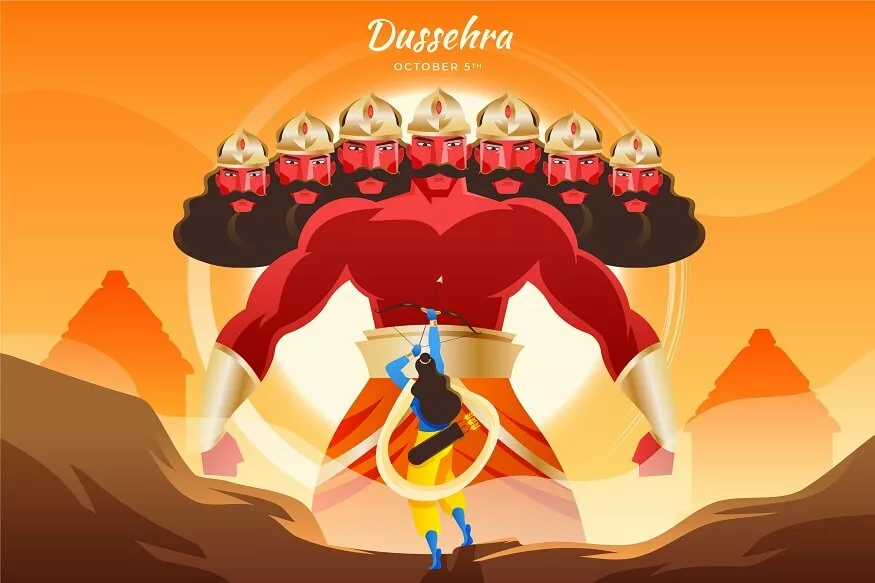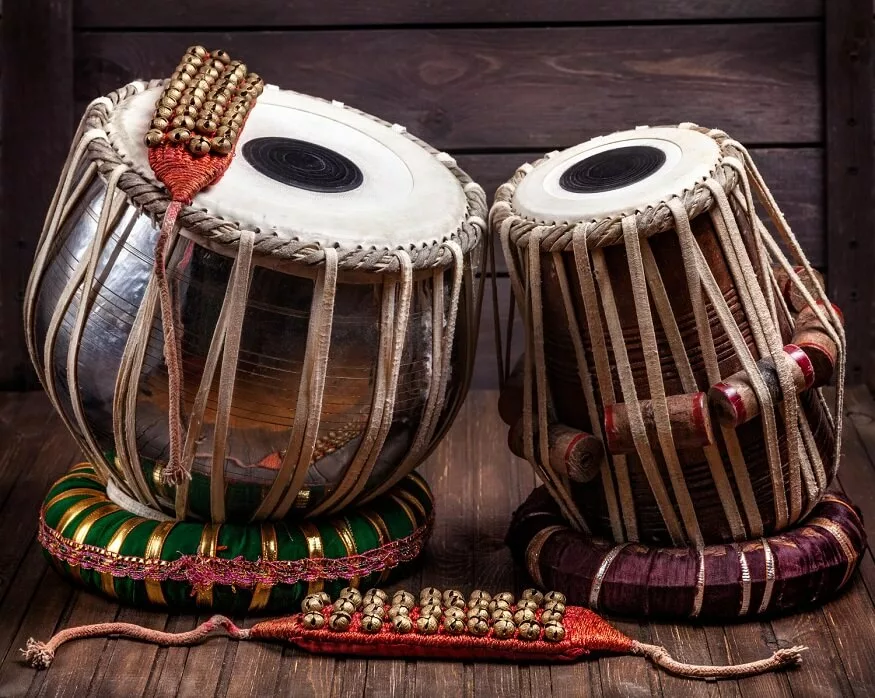The Dussehra celebration, also known as Vijay Dashami, commemorates the triumph of good over evil. Ravana kidnapped Devi Sita and sent her to Lanka. Lord Rama slew the Demon King Ravana as a result of this deed. The word ‘Dussehra’ is made up of two words: Dus and Ahara. The word ‘Dus’ signifies ten, while the word ‘Ahara’ indicates day. The celebration is usually held in September and October on the Gregorian calendar. The triumph of good over evil will be celebrated on Tuesday, October 24th, 2023.
Also Read: Krishna Janmashtami 2023 – Know All about the Festival
Dussehra History and Importance
Durga Puja or Vijayadashami in the East and North-east, Dussehra in the Northern and Western states are the diverse names for Dussehra. There are various mythical stories associated with the Dussehra celebration, but the most well-known is the fight between Lord Rama and the evil king Ravana. Ravana kidnapped Rama’s wife, Sita, and brought her to his realm in Lanka, according to tradition. Rama and his brother Lakshmana set out to rescue Sita, accompanied by an army of monkeys. Rama killed Ravana and rescued Sita after a long and terrible struggle.
Also Read: Onam 2023: History and significance of the festival
Rama’s victory against Ravana is viewed as a triumph of good over evil.
Dussehra 2023 will be celebrated across India with a variety of customs and cultural activities but with a unifying theme: the triumph of virtue over evil. Huge processions, Ravana Dahan, Ramleela, and Kanya Pujan are all common rituals. In addition, in various regions of the country, people commemorate Dussehra with weapon worship (shastra pujan) and philanthropy.
Dussehra 2023 traditions
Some people observe Vijayadashami after Durga Puja to commemorate the goddess Durga’s victory over Mahishasura in order to restore and safeguard dharma. For some, Vijayadashami recalls the victory of the deity Rama over Ravan.
Processions to a river or ocean with statues of Durga, Lakshmi, and Ganesha while chanting and listening to music are traditional ways to celebrate. The celebration also kicks off the countdown to Diwali (the festival of lights), which falls twenty days after Vijayadashami.
Dussehra 2023 India: Dussehra which means “the tenth day of victory,” is a major Hindu holiday celebrated with great pomp and passion throughout the country and around the world.
Why do we celebrate Dussehra; The celebration of Dussehra marks the end of Navratri and, for many people, the start of preparations for Diwali, a festival of lights that celebrates the triumph of virtue over evil.
In India, why do we celebrate Dussehra? What exactly is the importance of Dussehra?
The cultural and theological significance of the Dussehra celebration differs across the Indian subcontinent. For example, Vijayadashami marks the end of Durga Puja in India’s southern, eastern, northeastern, and northern regions. The day commemorates the goddess Durga’s victory over the buffalo monster Mahishasura to restore and protect dharma. In contrast, this event commemorates Lord Rama’s victory over the demon king Ravana throughout the country’s northern, central, and western states. The day also commemorates Arjuna’s, a Pandava warrior, triumph over the Kauravas in the Mahabharata. Dussehra 2023 is a national holiday for India.
Also Read: Ganesh Chaturthi 2023: Why Ganpati Utsav Is So Important to Us
5 Interesting facts about Vijay Dashami
Why are the idols immersed?
The immersion of the idol in Vijay Dashami represents how a deity passes from the formless (clay) to form (the idol) and back to formlessness in water — bringing nature and cosmic energies into harmony.
Kullu Dussehra
There is a festival called Kullu Dussehra which is an international festival and attracts lakhs of people from across the world.
The real war is within us.
Above all, the meaning of Dussehra is about spiritual development. Within each of us, there is a war between good and evil, and we must strive to overcome the inner negativity.
On this day, Asoka became a Buddhist.
On Vijayadashami, the renowned conqueror Asoka turned to Buddhism, pledging never to hold a weapon again.
Why did Ravana have ten heads?
Ravana’s ten heads signify his understanding of the six “Shastras” and four “Vedas.” Some believe they represent the ten human vices that must be symbolically burned in our search for salvation. Dussehra 2023 will make it possible for you to witness Ravana’s 10 heads vibrations of the festival.
How to observe Vijay Dashmi?
● Attend a Dussehra festival.
During the fair, you can see idols, delicacies, handicrafts, and a performance of “Ram Leela.” Almost the majority of them culminate in the ceremonial burning of a Ravana effigy, which may also involve a fireworks display!
● Study the Ramayana.
The epic Ramayana can be found in a variety of languages. It’s a wonderful narrative to read about King Rama’s life.
● Pay a visit to a Hindu temple.
During Vijayadashami, temples host unique events that are open to the public. Meaning of Dussehra is linked with visiting a Hindu temple.
Meaning of Dussehra? Why is it important?
It celebrates the victory of good over evil.
It reinforces our conviction that evil cannot triumph and that a heavenly power keeps an eye on us. Dussehra 2023 will give you a chance to witness the power of the festival.
It is a time for spiritual awareness.
Rama’s death of Ravana is also symbolic, with Ravana’s ten heads signifying ten human vices. This is the moment to pray and overcome our flaws.
It’s an auspicious day to begin something new.
On this day, young children are introduced to learning in several parts of southern India. In fact, today is an excellent day to begin any activity.
Northern India celebrates Dussehra
The celebrations of this day begin on Navratri itself in the northern part of the country. Dussehra celebrations begin a month before the actual festival, with cities lighting up with fairs, plays, and decorations, among other things. In a 10-day period, plays based on the Ramayana and Ramcharitmanas are performed in every nook and cranny of the city, depicting the story of Lord Rama, Lakshman, Sita, and Hanuman and their victory over Ravana through narrations, recitals, and songs. On the tenth day of Ramlila, effigies of Ravana are burned in front of cheering onlookers, symbolising the triumph of good over evil.
Western India celebrates Dussehra.
People in Western India venerate Lord Rama and Goddess Durga and celebrate their achievements. Some individuals in Gujarat also fast and visit temples. In Maharashtra, processions with singing and dance are held in which people carry the idols of the deities that they have installed in their homes on the first day of Navratri and immerse them in water before bidding farewell.
India’s eastern region Dussehra Festival
Durga Puja of Navratri is the most important festival in Eastern India, particularly in West Bengal, and it lasts for nine days. Vijay Dashami is the tenth day of the Hindu calendar, on which devotees parade enormous clay figurines of Goddess Durga to the river and say her farewell with devotional hymns.
Dussehra Festival in Southern India
Vijay Dashami celebrations in 2023 encompass a variety of rituals and traditions throughout Southern India. This festival honours Goddess Saraswati, the goddess of knowledge and learning. Many people start their studies in cultural fields such as classical dance or music on this day, and they also thank their teachers. The first three days of this festival in Tamil Nadu are dedicated to Goddess Lakshmi, the following three days to Goddess Saraswati, and the final three days to Goddess Durga.
Also Read: Cultural Influences on Child Nutrition: How traditions and local diets shape nutritional choices
Conclusion
At EuroSchool, Children learn about Dussehra thoroughly. In various regions of India, Dussehra or Vijayadashami is celebrated to honour Durga’s victory over Mahishasura. The tenth day of Vijayadashami commemorates the ten-day fight between Goddess Durga and Mahisahasura. Vijayadashami, as the name implies, is the tenth day of victory, which is why we celebrate Dussehra.










